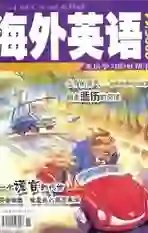非凡而又敏捷的家蝇
2006-11-30JoelAchenbach
Joel Achenbach
张锐/编译
Afly can do one thing extremely well: fly. Recently a team of British scientists declared that the common housefly is the most talented aerodynamicist on the planet, superior to any bird, bat,or bee. A housefly can make six turns a second; hover; fly straight up, down, or backward; do somersaults; land on the ceiling; and perform various other show-off maneuvers. And it has a brain smaller than a sesame seed.
Michael Dickinson, who studies fly flight in his lab at Caltech, says the housefly isnt actually the best flier. “Hoverflies are the be-all and end-all,” he says. They can hover in one spot, hurtle through the air to another location, and then race back to their original hovering point—precisely.
Scientists, engineers,and military researchers want to know how creatures with such small brains can do that. Maybe they could reverse-engineer a fly to make a robotic device that could reconnoiter dangerous places,such as earthquake zones or collapsed mines.
Dickinsons laboratory works with fruit flies. Researchers put them in chambers and manipulate the visual field, filming the flies in super-slow motion, 6,000 frames a second. Dickinson is interested in knowing how flies avoid collisions. He has found that certain patterns, such as 90-degree turns,are triggered by visual cues and two equilibrium organs on their backs that function like a gyroscope.
Flies have only a dozen muscles for maneuvering, but theyre loaded with sensors. In addition to their compound eyes, which permit panoramic imagery and are excellent at detecting motion, they have wind-sensitive hairs and antennae. They also have three light sensors,called ocelli, on the tops of their heads, which tell them which way is up. Roughly two-thirds of a flys entire nervous system is devoted to processing visual images. They take all this sensory data and boil it down to a few basic commands, such as “go left” and “go right”.
Given that flies have evolved for hundreds of millions of years ( and that they were the first animals to take to the air ), we shouldnt be surprised that theyre such good fliers. “They just dont have brains like ours. Studying flies,” says Dickinson,“is like traveling to another planet.”
一只家蝇能把一件事做得出奇得好,那就是:飞行。最近,一组英国科学家宣布,普通的家蝇是地球上最天才的空气动力学家,它比任何的鸟、蝙蝠或蜜蜂都要高明许多。一只家蝇能在一秒钟之内做6个旋转动作;它能在空中旋停;向上直飞、向下直飞、向后直飞;它能翻筋斗;降落在天花板上;而且它还能做出各种各样炫目的飞行动作。而它的大脑比一粒芝麻籽还要小。
迈克尔·迪肯森一直在加利福尼亚理工学院的实验室里研究家蝇的飞行。他说,家蝇事实上并不是飞行技能最好的飞行动物,他说:“食蚜虻才是最高明的飞行动物。”它们能旋停在空中的一个点上,然后又在空中猛地冲到另一个地点,之后再全速飞回到它们原来所旋停的那个点上,做得非常精确。
科学家、工程师以及军事研究人员都想知道,大脑如此之小的动物是怎样做到这一点的。也许他们可以通过对家蝇的研究对它们进行仿制,制造出一个仪器,可以用它来勘察危险的地区,如地震带或坍塌的矿井地带。
迪肯森的实验室是用果蝇作为研究对象的。研究人员把它们放在小室中,并且通过对视野的巧妙处理,用每秒6000个画面的方式,给果蝇拍摄电影。迪肯森很想知道蝇类是怎样避免碰撞的。他发现,某些模式,如90°转弯这个飞行动作,就是被看得见的信号所触发的,在它们的脊背上有两个平衡器官,其功能相当于一个陀螺仪。
家蝇只有12块肌肉可以用来做动作,但它们的身上却布满了感觉器官。它们的复眼能让它们看到全景的画像,并且在探测动作方面,它们的复眼也是很优秀的。除了复眼之外,它们还有对风敏感的毛发和触须。它们还有三个光感觉器官,叫单眼,就长在它们的头顶上。这三个感觉器官能告诉它们哪个方向是“上”。一只家蝇的整个神经系统大约有三分之二是用来处理视觉图像的。它们处理所有的这些感觉数据,并且将之压缩简化为几个基本的指令,比如“向左飞”或“向右飞”。
家蝇已经进化了很多亿年(而且它们是最先学会飞行的动物),考虑到这一点,我们就不应该惊奇它们是飞行技能如此好的飞行动物。迪肯森说:“它们只是没有同我们一样的大脑。研究家蝇的过程就好像是去往另一个行星的旅程。”
